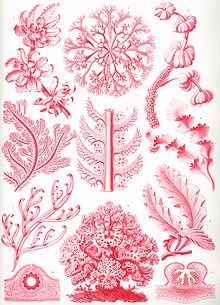Florideophyceae
| Florideophyceae Temporal range:
| |
|---|---|

| |
| "Florideae" from Ernst Haeckel's Kunstformen der Natur, 1904 | |
| Scientific classification | |
| (unranked): | Archaeplastida |
| Division: | Rhodophyta |
| Subdivision: | Eurhodophytina
|
| Class: | Florideophyceae Cronquist, 1960[2] |
| Subgroups | |
Florideophyceae is a class of exclusively multicellular red algae.[3][4] They were once thought to be the only algae to bear pit connections,[5] but these have since been found in the filamentous stage of the Bangiaceae.[6] They were also thought only to exhibit apical growth, but there are genera known to grow by intercalary growth.[6] Most, but not all, genera have three phases to the life cycle.[6]
Classification

There are various classification schemes; see red algae. One option is to use the following:
Subclass Hildenbrandiophycidae
Subclass Nemaliophycidae
- Acrochaetiales
- Balbianiales
- Balliales
- Batrachospermales
- Colaconematales
- Nemaliales
- Palmariales
- Entwisleiales
- Thoreales
Subclass Corallinophycidae
- Corallinales
- Corallinapetrales
- Rhodogorgonales
- Sporolithales
The subclass Corallinophycidae was introduced in 2007.[7]
Subclass Ahnfeltiophycidae
Subclass Rhodymeniophycidae
- Bonnemaisoniales
- Ceramiales
- Gelidiales
- Gigartinales
- Gracilariales
- Halymeniales
- Nemastomatales
- Peyssonneliales
- Plocamiales
- Rhodymeniales
- Acrosymphytales
- Atractophorales
- Catenellopsidales
- Sebdeniales
According to molecular clock analysis, Florideophyceae diverged from other red algae about 943 (817–1,049) million years ago. It split into Hildenbrandiophycidae ca. 781 (681–879) mya, Nemaliophycidae ca. 661 (597–736) mya and Corallinophycidae ca. 579 (543–617) mya, and ca. 508 (442–580) mya the split between Ahnfeltiophycidae and Rhodymeniophycidae occurred.[1]
